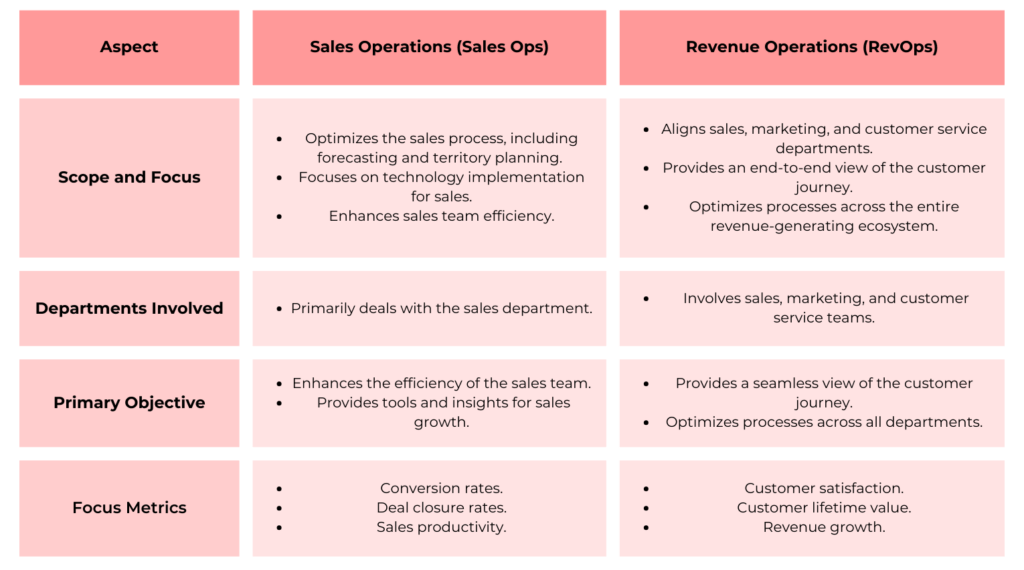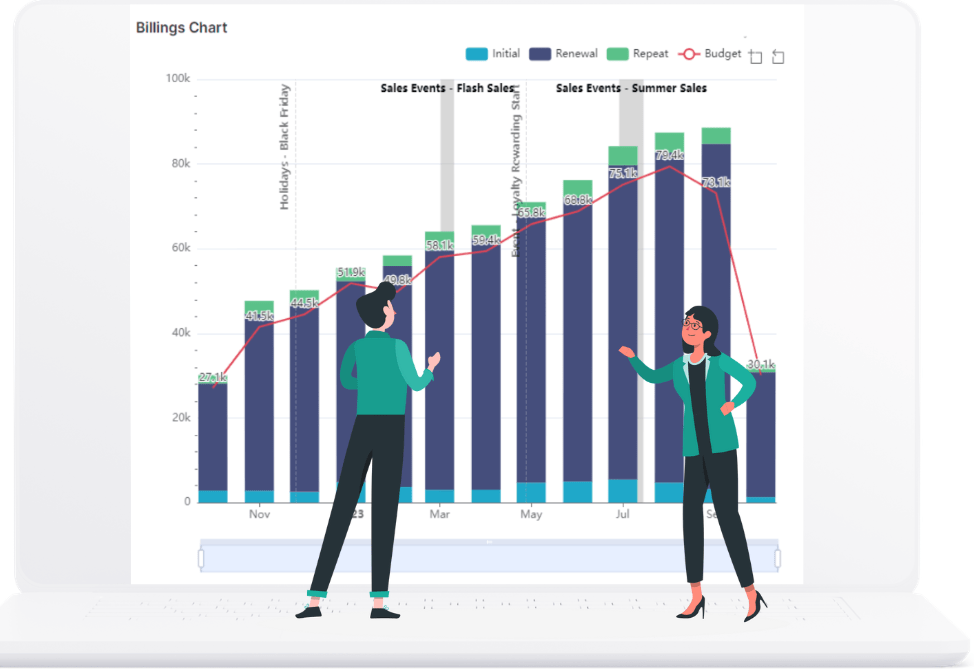In today’s dynamic business landscape, where customer expectations are higher than ever, traditional methods of managing sales, marketing, and customer service are no longer sufficient. Qmantic is a revolutionary Business Intelligence (BI) platform that reshapes the way businesses approach Revenue Operations (RevOps). This article goes into the concept of RevOps but also illustrates how Qmantic’s cutting-edge solutions empower businesses to optimize revenue growth in the digital age.
Understanding Revenue Operations (RevOps)

What is RevOps and Why Does it Matter?
RevOps, an abbreviation for Revenue Operations, is not just another buzzword; it’s a strategic integration of sales, marketing, and service departments. Beyond demolishing traditional departmental silos, RevOps is about providing a holistic, 360-degree view of your business. It’s about enhancing customer experiences, improving operational efficiency, and, most importantly, maximizing revenue. But how does RevOps achieve this, and why is it crucial in the contemporary business landscape?
The Role of RevOps in Business Growth
A RevOps approach extends its reach to every customer-facing department. It acts as a central hub for customer information, focusing on acquisition, recurring revenue, customer satisfaction, and more. But it’s not just about collecting data; it’s about turning that data into actionable insights. How does RevOps facilitate this and why is it indispensable in today’s customer-centric world?
What Are the Core Functions of Revenue Operations?

Sales Operations
Sales Operations encompass an array of vital functions that revolve around optimizing the sales process. Moreover, this includes fine-tuning territory planning and management, forecasting sales, tracking performance, managing deals, and analyzing pipeline data. These activities are the bedrock of RevOps, ensuring that the sales team operates at its most efficient and effective.
Marketing Operations
Marketing Operations take the lead in crafting and executing strategic marketing campaigns. Additionally, this includes planning and executing campaigns, generating and managing leads, implementing marketing automation tools, and rigorously analyzing the return on investment (ROI). Moreover, it encompasses customer segmentation and targeting to tailor marketing efforts for maximum impact.
Customer Service Operations
The customer service arm of RevOps is a dedicated force focused on ensuring customer satisfaction and retention. Furthermore, this entails managing customer support, analyzing feedback, formulating strategies to retain customers, and efficiently managing service level agreements (SLAs). Continuous improvement is the driving force behind customer service processes, resulting in enhanced customer experiences.
Data Analysis and Insights
RevOps relies heavily on data, and this function is tasked with collecting and integrating data from various sources. In addition, it involves data analysis and visualization, diving deep into customer behavior, and employing predictive analytics to identify sales and customer trends. Business intelligence reporting completes the data-driven cycle.
Technology Integration
This function deals with integrating and managing the technology tools crucial for the smooth functioning of RevOps. Moreover, this includes managing Customer Relationship Management (CRM) systems, implementing marketing automation tools, overseeing sales enablement software, and ensuring seamless integration of customer service platforms and data analytics and reporting tools.
Cross-Departmental Collaboration
RevOps flourishes on the synergy of its constituent departments. Additionally, Cross-Departmental Collaboration is all about facilitating communication and collaboration between the sales, marketing, and customer service teams. It ensures that their goals and strategies align seamlessly, resulting in a unified operational approach.
Performance Metrics and KPIs
This function is instrumental in defining and tracking key performance indicators (KPIs) to monitor the health of RevOps. Furthermore, it involves meticulous monitoring and analysis of revenue-related metrics, evaluating customer satisfaction scores, measuring customer lifetime value (CLV), and keeping a close eye on customer churn rates and retention metrics.
Process Optimization and Streamlining
Continuous improvement and efficiency are at the heart of RevOps, and therefore, this function focuses on identifying bottlenecks and inefficiencies in existing processes. Also, it streamlines workflows, eliminates redundant tasks, and enforces best practices, resulting in an agile and highly efficient revenue generation machine.
Revenue Operations Metrics: A Comprehensive Overview
Sales Cycle Time
The time it takes, in days, weeks, or months, from the first contact with a prospect to closing a deal.
Pipeline Velocity
Measures the speed at which prospects move through your sales pipeline, indicating sales success against time.
Renewals and Upsells
Tracks the number of subscription renewals or product upsells, indicating customer satisfaction.
Customer Lifetime Value (CLV)
Reflects how much a customer is worth to your business over their entire engagement, including upsells and renewals.
Customer Churn Rate
Moreover, it represents the percentage of customers who discontinue using your product or service within a specified timeframe.
Customer Acquisition Cost (CAC)
Measures the cost incurred in marketing and sales efforts to acquire a new customer.
Annual Recurring Revenue (ARR)
This metric calculates the revenue generated from subscription-based products on an annual basis.
Forecast Accuracy
In addition, it assesses how accurately revenue predictions align with the actual revenue generated, aiding in precise financial planning.
Win Rate
Likewise, this metric indicates the percentage of successfully closed sales deals concerning the total number of deals pursued.
Customer Retention Rate
Similarly, it measures the percentage of customers retained over a specific period, reflecting customer loyalty and satisfaction.
Expansion Revenue
Similarly, this metric accounts for revenue generated from existing customers through methods like upsells, cross-sells, or additional purchases.
Net Promoter Score (NPS)
Measures customer loyalty and satisfaction based on the likelihood of customers recommending your product or service.
RevOps vs. SalesOps: Unraveling the Differences

Implementing RevOps with Qmantic
Qmantic’s suite of dashboards offers a powerful toolset for gaining in-depth insights into your financial data and optimizing revenue operations. Furthermore, by exploring these dashboards, businesses can achieve a profound understanding of their financial landscapes, going beyond mere numbers to decode the intricacies of revenue operations.
- Billings vs. Budget Dashboard: Delve into detailed financial landscapes, deciphering revenue intricacies and enabling data-driven strategic decisions.
- Sales Funnel Dashboard: Gain a crystal-clear visualization of revenue pipelines, identifying bottlenecks and ensuring seamless customer journeys for enhanced conversions.
- Revenues Dashboard: Experience tailored insights, breaking away from generic data to understand unique revenue breakdowns, income origins, and customer behaviors.

Conclusion: Choose Qmantic for Revenue Excellence
At Qmantic, we don’t just offer a BI platform; we provide a transformative experience. Revolutionize your revenue operations with our visually appealing and responsive design, ensuring intuitive exploration of revenue analytics on any device.
Are you ready to embark on a journey toward optimized revenue operations?
Dive into the future of business success with Qmantic today. Visit our dedicated RevOps page to explore how Qmantic can revolutionize your revenue operations, making success not just a goal but a tangible outcome. Let’s transform your business story together.
FAQs
Qmantic’s differentiator lies in its commitment to customization. Furthermore, our platform adapts to your business, offering tailor-made solutions that align with your unique needs, ensuring a seamless experience that fosters growth and innovation.
Qmantic’s user interface is designed with simplicity in mind. Additionally, our intuitive design ensures that even non-technical users can navigate complex data effortlessly, enabling every team member to make data-driven decisions without a steep learning curve.
Absolutely! Qmantic is engineered for compatibility. Whether you use a popular CRM system or specific business tools, our platform seamlessly integrates, ensuring a harmonious workflow across your organization’s tech stack.
Security is our utmost priority. Moreover, Qmantic employs state-of-the-art encryption protocols and adheres to industry best practices, ensuring your data remains confidential and secure. We provide you with peace of mind, allowing you to focus on leveraging insights to drive your business forward.
Absolutely. Qmantic’s scalability is one of its core strengths. Whether you’re a nimble startup aiming for rapid growth or an established enterprise seeking efficiency, our solutions can be tailored to meet your specific requirements. Qmantic’s adaptability ensures that businesses of all sizes can harness the power of RevOps for sustainable success.





